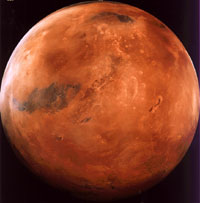Mars (FASA)
| Coordinates | 23.9, 61.8, 0.0[1] |
| Affiliation | Member,[2] United Federation of Planets[3] |
| Astrography | Quadrant I (UFP),[2] Sol IV[3] |
| Class | M (Terraformed from Class K)[1] |
| Notable Species | Humans[4] |
| Advertising |
Originally a Class K planet, Mars was terraformed to become Class M.[1] Mars is the fourth planet in the Sol system,[3] located in Quadrant I of the United Federation of Planets.[2]
Early exploration of Mars began in 1976 with the Viking 1 probe, which landed on the planet and transmitted photographs, climatic measurements, and soil composition data back to Earth. The Mars Sample Return Probe was launched in 1988; it retrieved soil and rocks for analysis on Earth when it returned in 1991. Colonization of Mars began in 2012, with the establishment of Marsbase 1, humanity's first interplanetary outpost, which was tasked with searching for life, past or present, on the red planet, among other scientific objectives. Fifteen astronauts were led by Director Mark Glynn. Marsbase 2 was established in 2015, continuing the mission begun by Marsbase 1. Mars exploration expanded once again with the establishment of Marsbase 3 in 2018, which was tasked with an in-depth study on the mining of materials from the Martian moons, Phobos and Deimos, and mining began on Deimos a year later. The first signs of extraterrestrial life was found in the form of fossilized, insect-like creatures in 2021.[5]
Mars gained its independence from Earth in 2062,[5] after a document called the "Fundamental Declaration of the Martian Colonies" was published,[4] which asserted that the Mars colonists were entitled to the same political and legal rights as anyone living on Earth.[1] In 2105, a serial murderer killed eight women, a crime that would go unsolved until 2208.[6] Once the Federation was founded, Mars became a member in its own right, and by Reference Stardate 2/2306.01 (1 June 2223), the population of Mars had reached 15.74 billion. Planetary concerns included industry, trade, shipbuilding, and Star Fleet support facilities. By 2223, Martian shipbuilding facilities, such as the Utopia Planitia Shipyards,[7] produced an average of 1 Excelsior class battleship, 6 cruisers, 13 destroyers, 28 escorts, 4 scouts, and 28 civilian and commercial vessels.[2]
Notes and References
- ↑ Jump up to: 1.0 1.1 1.2 1.3 Maynard, Jeff (Author). Star Trek Maps. Star Trek. Book. Bantam Books. August 1980.
- ↑ Jump up to: 2.0 2.1 2.2 2.3 Menke, Bernard Edward and Rick David Stuart (Authors). The Federation. Star Trek: The Role Playing Game. Book 2011. Cover art by David R. Deitrick. Illustrations by Todd F. Marsh, John C. Tylk, Bob Eggleton, Daniel E. Carroll, and Jay Harris. FASA Corporation. 1986.
- ↑ Jump up to: 3.0 3.1 3.2 Template:RefTOS00
- ↑ Jump up to: 4.0 4.1 Roddenberry, Gene (Executive Producer). "The Galileo Seven." Star Trek, Season 1, Episode 16 (Production 14). Directed by Robert Gist. Story by Oliver Crawford Teleplay by Oliver Crawford & S. Bar-David. Desilu Productions, 5 January 1967.
- ↑ Jump up to: 5.0 5.1 Goldstein, Stan et al (Authors). Spaceflight Chronology. Star Trek. Book. Wallaby Books. 1980.
- ↑ Roddenberry, Gene (Executive Producer). "Wolf in the Fold." Star Trek, Season 2, Episode 7. Directed by Joseph Pevney. Written by Robert Bloch. Desilu Productions, 22 December 1967.
- ↑ Roddenberry, Gene (Executive Producer). "Encounter at Farpoint". Star Trek: The Next Generation, season 1, episode 1-2 (Production number 101-102). Co-Executive Producers: Rick Berman & Maurice Hurley. Directed by Corey Allen. Written by D.C. Fontana & Gene Roddenberry. Paramount Pictures. 28 September 1987.


